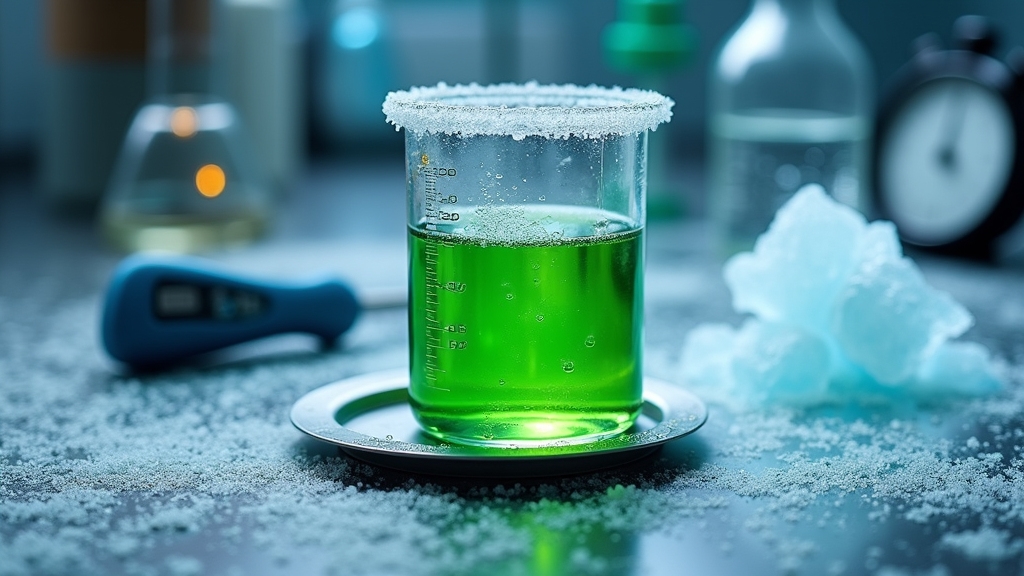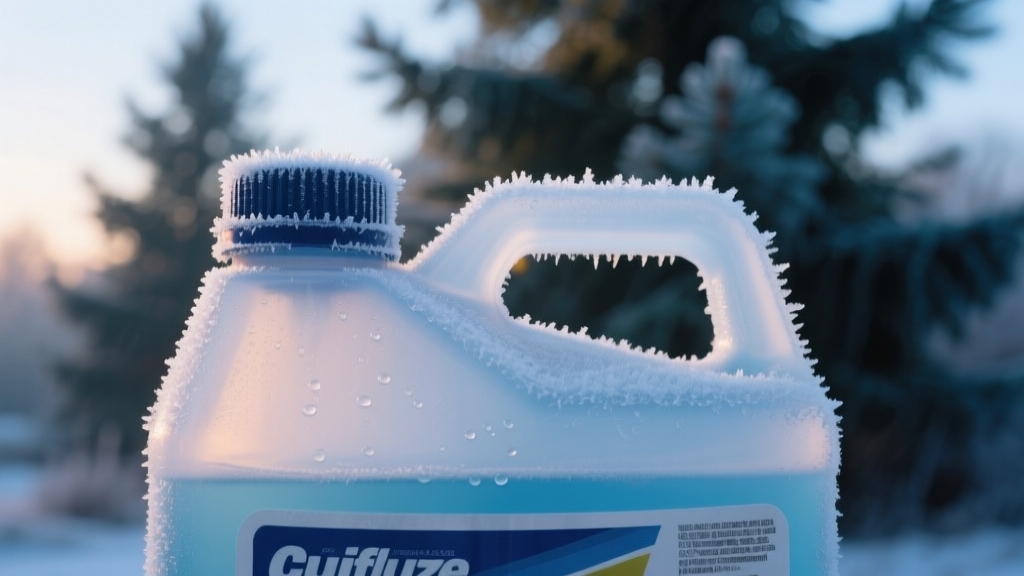Last Updated on October 12, 2025
RV antifreeze doesn’t freeze solid at typical freezing temperatures; it begins to slush well above its rated freeze point but only fully freezes at its burst point, which can be as low as –50°F. This slurry remains fluid enough to prevent immediate damage.
Proper antifreeze concentration and selection matter; you want a formula rated for your climate to protect pipes and tanks reliably. Understanding these temperature thresholds and how antifreeze behaves physically guarantees your system stays safe during cold snaps and winter storage.
Key Takeaways
- RV antifreeze begins to slush at its freeze point but only solidifies and risks pipe damage at its lower burst point temperature.
- Properly rated antifreeze (e.g., -50°F) remains liquid and prevents freezing damage down to its burst point.
- Incorrect concentration or dilution can raise freeze and burst points, increasing the risk of freezing in RV plumbing.
- Propylene glycol antifreeze contracts and resists freezing damage, but ice crystals can form near freeze point without causing solidification.
- Regular testing with a refractometer ensures antifreeze maintains freeze protection and does not freeze in cold conditions.
Understanding Freeze Point and Burst Point in RV Antifreeze
Although you might notice RV antifreeze becoming slushy at temperatures above its rated freeze point, it doesn’t solidify completely until reaching its burst point, the critical temperature where expansion can cause pipe damage.
RV antifreeze may slush above its rated freeze point but only solidifies at the burst point, risking pipe damage. The freeze point marks when antifreeze begins to form slush, but the liquid remains partially fluid, posing no immediate risk.
Choosing the correct antifreeze with suitable temperature tolerance can help protect your RV plumbing effectively. The burst point is much lower, indicating the temperature at which antifreeze freezes solid and expands, risking pipe rupture.
For example, a -50°F rated antifreeze starts slushing near +20°F but only reaches its burst point at -50°F. Understanding this distinction helps you select antifreeze suitable for your climate.
It ensures protection against freezing damage by preventing temperatures from dropping to the burst point while tolerating harmless slush formation above it. Proper disposal of antifreeze is essential to prevent harm to pets and humans, so always follow guidelines for safe disposal.
Temperature Ratings and Their Impact on Antifreeze Performance
Hey there! It’s really important to know the difference between freeze point and burst point when it comes to RV antifreeze. You see, the temperature ratings on these products show you just how low the temperature can get before you run into trouble with your pipes.
Understanding these ratings helps you choose antifreeze with the right temperature resistance for your specific climate needs. Most of these ratings go down to about -50°F or even lower. This basically tells you how well the antifreeze can keep ice from forming and, more importantly, how it protects your plumbing from potential damage.
For example, some antifreeze options are non-toxic and safe for potable water systems, making them ideal for RVs with drinking water lines.
Freeze Point vs Burst
When selecting RV antifreeze, understanding the distinction between freeze point and burst point is essential because they determine how the fluid behaves under cold conditions.
The freeze point marks when ice crystals first form, often much higher than the rated protection temperature. The burst point is the critical low temperature at which ice expansion can rupture pipes.
Additionally, antifreeze rated for lower temperatures, such as -100°F, is available to provide enhanced protection in extremely cold climates or for marine engines, ensuring greater safety against freezing damage.
Prioritize burst point ratings to avoid costly damage and ensure reliable performance during winter conditions by using products designed for temperature tolerance.
| Parameter | Description |
|---|---|
| Freeze Point | Temperature where ice crystals begin forming |
| Burst Point | Temperature where antifreeze solidifies and bursts pipes |
| Practical Impact | Freeze point signals risk; burst point dictates safe use limits |
Temperature Ratings Explained
Because antifreeze concentration directly influences its freeze and burst protection temperatures, understanding temperature ratings is essential for maintaining your RV’s plumbing integrity under cold conditions.
These ratings specify the lowest temperature at which the antifreeze prevents solid freezing or pipe bursting due to expansion. Propylene glycol-based antifreeze typically offers superior protection, with common burst ratings around -50°F and specialized formulations extending to -100°F.
Maintaining proper concentration is critical; dilution reduces effectiveness and raises the risk of freeze damage. Regular maintenance helps ensure the antifreeze retains its protective properties over time.
Temperature ratings guide you in selecting antifreeze suitable for your climate, ensuring it withstands expected lows without compromising seals or septic systems.
Applying antifreeze that meets or exceeds your region’s minimum temperatures optimizes winterizing efforts, preventing costly plumbing failures during cold exposure. Unlike engine coolant that is designed for engine temperature regulation, RV antifreeze is specifically formulated for plumbing protection during freezing conditions.
Performance in Cold
Temperature ratings indicate the lowest temperature at which antifreeze prevents pipe bursting, not the initial ice crystal formation. Propylene glycol-based RV antifreeze may start forming ice crystals near +10°F but continues contracting, avoiding expansion that causes bursts, down to its rated protection temperature, often -50°F.
Testing shows that many coolants crystallize well below typical freezing points, yet still maintain protective properties against damage freeze resistance. Consider the temperature performance range when selecting antifreeze, as different formulations perform better under varying cold conditions.
You should maintain proper antifreeze-to-water ratios, typically 50/50, to ensure freeze resistance aligned with these ratings. Deviations can raise freeze points, compromising protection. Even with ice crystals present, antifreeze maintains burst protection by remaining flexible.
Over time, additives degrade, reducing efficacy, so regular testing with a hydrometer and timely replacement are essential for reliable cold-weather performance in your RV plumbing system.
Physical Changes of RV Antifreeze in Cold Conditions
Although RV antifreeze is engineered to remain liquid at extremely low temperatures, you’ll notice that ice crystals begin forming around +10°F, signaling the onset of phase changes within the mixture.
This phase shift is gradual due to the propylene glycol base, which contracts progressively as temperatures drop, preventing the abrupt freeze typical of pure water. Propylene glycol is preferred because it is non-toxic and safe for potable water systems.
Selecting antifreeze with the appropriate temperature rating ensures optimal freeze protection for your RV plumbing. Between -10°F and -15°F, the antifreeze may appear almost solid, yet it retains its protective liquid properties.
Importantly, expansion that risks pipe damage doesn’t occur until near -50°F, when the mixture begins to behave like ice. This contraction below freezing reduces internal pressure, enhancing freeze protection.
The antifreeze’s mixture composition controls these physical changes, enabling it to maintain fluidity and avoid mechanical stress across a broad low-temperature range.
Testing Methods to Measure Antifreeze Freeze Protection

When you need to verify the freeze protection level of RV antifreeze, selecting the right testing method is critical. Use a refractometer calibrated specifically for propylene glycol (PG) to measure freeze points accurately. Many RV owners use easy installation tools to quickly upgrade their systems without hassle.
Test strips offer less precision, and ethylene glycol testers give false readings for PG antifreeze. Digital or optical refractometers detect the initial ice crystal formation (freeze point), which is essential for pumpable systems.
Noting burst point temperatures reveals when the solution solidifies and risks damage during storage. Proper sampling involves collecting fluid post-flush to avoid contamination and calibrating your refractometer with distilled water. It is important to test the antifreeze concentration regularly, especially after winter, to ensure adequate freeze protection.
Record results before and after application to ensure desired protection. Regular testing guards against dilution or degradation. Understanding both freeze and burst points helps optimize antifreeze concentration, balancing effective freeze protection with minimizing damage risk.
Compatibility and Safety of RV Antifreeze With Plumbing Materials
When choosing RV antifreeze, it’s super important to make sure it’s compatible with your plumbing materials. You’ve got to consider things like copper, PVC, and PEX—just steer clear of acetate plastics. Using products with compatibility testing helps avoid damage to diverse materials in your RV’s plumbing system.
It’s really best to go with non-toxic, propylene glycol-based formulations. This way, you’ll keep your potable water systems safe and avoid any damage to seals and hoses. Propylene glycol is known to be compatible with freshwater lines and tanks, which makes it ideal for RV use.
And hey, don’t forget about the proper usage guidelines! Applying the antifreeze correctly and rinsing it out afterward can make a big difference. It helps preserve the integrity of your system and keeps everything safe and sound.
Plumbing Material Compatibility
Because RV plumbing systems incorporate various metals and plastics, selecting an antifreeze compatible with these materials is critical to maintaining system integrity.
Propylene glycol-based antifreeze generally resists corrosion in copper and brass components and is safe for most plastics; however, some formulas are incompatible with specific plastics like acetate, so you must verify compatibility. It also contains corrosion inhibitors that protect metal components during winterizing.
Many high-quality antifreeze products include overheat protection additives to enhance safety during use. Ethanol-based antifreeze poses risks due to its solvent properties, potentially degrading rubber seals and plastic pipes, compromising valves and causing leaks.
Blended ethanol and propylene glycol products offer mixed benefits but require careful selection to avoid damage. Always consult manufacturer guidelines for seals made from specialized materials such as EPDM or Viton.
Ensuring your antifreeze matches your plumbing materials prevents premature failures and maintains system reliability during freeze protection.
Non-toxic Formulation Safety
Although RV antifreeze must protect plumbing systems from freezing, it also needs to maintain safety and compatibility with your RV’s materials.
Non-toxic formulations primarily use propylene glycol or ethanol, both verified safe for potable water systems and compatible with common plumbing materials like brass, copper, and plastic (excluding acetate). These antifreezes minimize corrosion and prevent degradation of seals, hoses, and metal components, reducing leak risks.
Propylene glycol-based antifreeze is ideal for long-term storage because it is FDA-approved and biodegradable. Many RV plumbing components require specific maintenance and safety features to ensure longevity and leak prevention when using antifreeze.
Their low toxicity, confirmed by toxicologists and regulatory bodies, ensures safety for families, pets, and the environment. Distinct coloring prevents accidental misuse, while biodegradability limits environmental impact.
Following manufacturer guidelines, you guarantee these antifreezes maintain plumbing integrity without introducing hazardous chemicals like ethylene glycol. This balance ensures freeze protection with chemical safety and material compatibility throughout your RV’s plumbing system.
Proper Usage Guidelines
When selecting and applying RV antifreeze, ensuring compatibility with your plumbing materials is essential to prevent damage and maintain system integrity. Use propylene glycol-based antifreeze, as it safely interacts with common plastics, rubber seals, hoses, brass, and copper pipes without causing degradation or drying.
Avoid ethanol-based formulas because they can dry out rubber seals, compromising system function. Never use automotive ethylene glycol antifreeze; it’s toxic and damages plastic components.
Apply antifreeze thoroughly after draining and blowing out water lines to prevent freezing. Traveller RV antifreeze offers burst-proof protection guaranteed down to -50°F, providing reliable winterization.
Replenish antifreeze regularly in holding tanks to counteract bacterial consumption. Do not add antifreeze to the water heater unless the manufacturer approves it. Always confirm the antifreeze is rated for potable water systems and store it securely to maintain safety and efficacy.
Choosing the Right Antifreeze for Different Climate Conditions
Selecting the right antifreeze for your RV requires careful consideration of local climate conditions to guarantee ideal freeze protection and system compatibility. Choosing RV antifreeze means matching it to your local climate for optimal freeze protection and system safety.
In cold climates, propylene glycol antifreeze is your best bet. It’s non-toxic, protects plumbing down to -50°F or lower, and preserves seal integrity during prolonged use. For extreme cold, specialized formulas protect -100°F. Propylene glycol-based antifreeze is also food-grade, environmentally friendly, and safe for pets and humans.
Moderate climates may only need diluted or lower-concentration antifreeze to balance protection and chemical exposure. Ethanol-based antifreeze, while cheaper, risks drying rubber seals and harming holding tank bacteria, making it less suitable for frequent use in cold regions.
Also, consider environmental safety. Propylene glycol’s higher flashpoint and non-toxicity to humans favor its use. Tailor your antifreeze type and concentration to your RV’s storage climate to optimize freeze protection and plumbing longevity.
Maintaining Effective Freeze Protection in Your RV Plumbing System
To maintain effective freeze protection in your RV plumbing system, you must guarantee that antifreeze is properly circulated through all water lines, including P-traps and holding tanks, to prevent freezing and damage.
Use a pump or winterization kit to ensure thorough distribution, bypassing water heaters to reduce antifreeze volume. It is important to drain and bypass the water heater to avoid wasting antifreeze and ensure efficient winterization.
Add 1-2 cups of antifreeze in sink drains to fill P-traps and 2-4 quarts into toilets to coat black water tanks. Regularly inspect lines for coverage and leaks before freezing temperatures arrive. Replace antifreeze older than two years to maintain efficacy, as evaporation lowers protection over time.
Proper winterization prevents pipe cracks, frozen holding tanks, and mechanical failures. This preserves plumbing integrity during cold exposure and minimizes costly repairs.
Frequently Asked Questions
Can RV Antifreeze Be Safely Disposed of in Household Drains?
Yes, you can safely dispose of small amounts of RV antifreeze in household drains, provided it’s propylene glycol-based and labeled safe for potable plumbing. Pouring limited quantities during winterization typically won’t harm septic systems or municipal wastewater treatment.
However, avoid disposing of large volumes to prevent environmental harm or regulatory violations. Always follow manufacturer guidelines and consult local regulations to guarantee compliance and protect wastewater infrastructure effectively.
How Long Does RV Antifreeze Remain Effective Once Opened?
You’ll find that opened RV antifreeze remains effective for 1 to 4 years, depending heavily on storage conditions and brand. To maximize its lifespan, keep it tightly sealed in its original plastic container, stored in a cool, dry, and dark place.
Exposure to air, moisture, or temperature fluctuations accelerates degradation. Always inspect for color, odor, or contamination changes before use, and replace it after 1–2 years for ideal protection.
Is RV Antifreeze Safe for Use in Potable Water Systems?
You can think of RV antifreeze as a guardian angel for your potable water system. It’s typically made from non-toxic propylene glycol, making it safe for human consumption when used properly.
It’s biodegradable and compatible with various piping materials, ensuring no chemical damage. Just make sure you use a product labeled non-toxic and intended for potable systems. Always follow manufacturer guidelines to maintain safety and system integrity.
Can Mixing Different Brands of RV Antifreeze Reduce Effectiveness?
Yes, mixing different brands of RV antifreeze can diminish its effectiveness. When you combine incompatible formulations, their corrosion inhibitors might neutralize each other, weakening freeze protection and increasing corrosion risk.
You may also experience gel formation that clogs plumbing. To maintain peak performance, avoid mixing types or brands without confirming chemical compatibility. Flush the system before switching and use a single, proven antifreeze brand to ensure reliable freeze and corrosion protection.
Does RV Antifreeze Protect Against Corrosion in Plumbing Systems?
Yes, RV antifreeze protects against corrosion in plumbing systems. It’s formulated with non-corrosive ingredients and additives that prevent metal degradation, especially in copper, brass, and aluminum components.
When you use it, you minimize risks of salt brine corrosion and maintain system integrity. This corrosion resistance ensures your plumbing lasts longer and functions reliably during off-season storage or cold weather conditions.
Protect Your RV Plumbing: Choose the Right Antifreeze Formula
You might think RV antifreeze is completely freeze-proof, but that’s not always the case. Depending on its formulation and temperature rating, it can reach a freeze point and potentially cause damage if you’re not careful.
Understanding these thresholds and testing your antifreeze regularly is essential to protect your plumbing system. So, before the cold hits hard, double-check your antifreeze because assuming it won’t freeze could cost you more than you expect.



